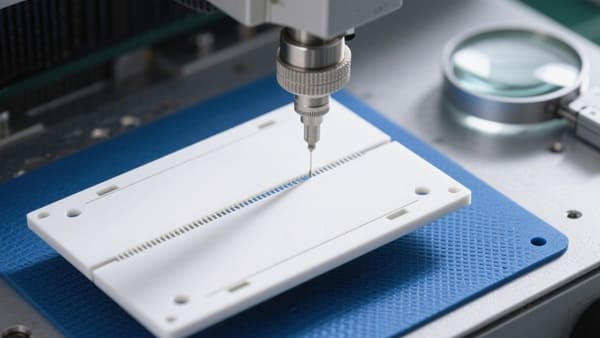Ceramic CNC Machining in Advanced Ceramics: Key Roles & Applications
Ceramic CNC machining plays a vital role in the production of precision parts made from hard and brittle materials like alumina, zirconia, and silicon nitride. These ceramics are used in extreme environments that demand tight tolerances, superior strength, and excellent wear resistance. This article will explore what ceramic CNC machining is, its process, advantages, challenges, comparison with other techniques, and its wide-ranging industrial applications. Whether you’re an engineer, buyer, or researcher, this guide helps you understand the strengths and limitations of CNC machining for advanced ceramics.
At Advanced Ceramic Hub, we specialize in high-quality ceramic products, ensuring optimal performance for industrial and scientific applications.

What Is Ceramic CNC Machining and How Does It Work?
Ceramic CNC machining refers to the precision removal of material from sintered or partially sintered ceramic blanks using diamond-coated tools in a computer-controlled system. Because ceramics are extremely hard and brittle, traditional machining methods are inadequate. CNC enables complex geometries and small tolerances to be achieved with minimal cracking or chipping.
| Feature | Description |
| Tool Type | Diamond-coated tools |
| Cooling Method | Air, mist, or minimal fluid |
| Motion Control | 3-axis or 5-axis CNC systems |
| Compatible Materials | Alumina, Zirconia, ZTA, Si₃N₄ |
CNC systems offer high repeatability and can be customized for various ceramic types, making them ideal for advanced applications across industries.
What Are the Advantages of CNC Machining for Ceramics?
The use of CNC in ceramic machining brings unique advantages that cannot be matched by molding or pressing. It provides high accuracy, eliminates tooling costs for low-volume production, and allows for post-sintered adjustments without compromising part integrity.
| Advantage | Impact on Performance |
| High dimensional accuracy | Enhances fit and longevity |
| Reduced surface damage | Maintains material strength |
| Complex geometry | Enables advanced part design |
| Consistent output | Supports scalable production |
These benefits are particularly useful in fields like medical devices and microelectronics, where even minor imperfections can cause failure.
What Are the Typical Steps in the Ceramic CNC Machining Process?
The machining of ceramics requires a precise, step-by-step approach to prevent cracking or tool failure. The process can differ slightly depending on whether the ceramic is in a green, bisque, or fully sintered state.
| Step | Description |
| Pre-sintering | Green body may be partially densified |
| Toolpath generation | Optimized G-code for brittle cutting |
| Rough machining | Material removed at low feed rates |
| Finish machining | Polishing and dimensioning to spec |
A strict workflow reduces the likelihood of defects and ensures the final part meets both mechanical and dimensional requirements.
Why Is CNC Machining Suitable for Advanced Ceramics?
Unlike metals or plastics, ceramics can fracture suddenly without visible deformation. CNC machining allows controlled removal with minimal mechanical stress. Combined with slow feed rates and sharp tools, it preserves ceramic integrity.
| Ceramic Type | Machining Difficulty | CNC Compatibility |
| Alumina | High | Excellent |
| Zirconia | Very High | Excellent |
| ZTA | Medium-High | Good |
CNC is the method of choice when precision is essential and the application environment is harsh, such as in aerospace or semiconductor devices.
What Ceramic Materials Can Be CNC Machined?
Not all ceramics can be effectively machined using CNC methods. The material must possess sufficient density and cohesion to avoid crumbling during the cutting process. Below are common ceramics suitable for CNC machining, particularly in their sintered or partially sintered states.
| Ceramic Material | Description and Typical Use |
| Alumina (Al₂O₃) | Electrical insulators, wear parts |
| Zirconia (ZrO₂) | Dental implants, precision bearings |
| ZTA (Zirconia Toughened Alumina) | Cutting tools, pump components |
| Silicon Nitride (Si₃N₄) | High-speed bearings, engine components |
| Macor | Machinable glass ceramic for low-load applications |
These ceramics are selected for CNC machining based on their mechanical properties, thermal resistance, and the need for high dimensional precision in end-use applications.
Explore our high-quality ceramic products.
How Does CNC Machining Compare with Other Ceramic Processing Methods?
While pressing and injection molding are ideal for mass production, they lack the flexibility of CNC. CNC machining is ideal for prototypes, small batches, and parts requiring tight tolerances and complex geometries.
| Method | Precision | Cost | Speed | Complexity Support |
| CNC Machining | High | High | Medium | Very High |
| Dry Pressing | Low | Low | Fast | Low |
| Injection Molding | Medium | Medium | Fast | Medium |
Choosing CNC means prioritizing quality, precision, and part reliability over cycle time and cost alone.
What Are the Key Applications of Ceramic CNC Machining?
CNC machining makes it possible to deploy advanced ceramics in critical applications where failure is not an option. These include medical tools, semiconductor fixtures, energy devices, and aerospace systems.
| Industry | Application Example |
| Aerospace | Thermal shields, fuel injector rings |
| Electronics | Substrates, insulator plates |
| Medical | Dental implants, prosthetics |
| Semiconductor | Wafer chucks, nozzle tips |
| Energy | Fuel cell seals, sensor housings |
These applications require high thermal resistance, mechanical strength, and zero tolerance for dimensional errors.
Request a custom quote for various ceramic products.
What Are the Common Challenges in Ceramic CNC Machining?
While effective, ceramic CNC machining is not without its obstacles. Tool wear is significant, and improper settings can cause chipping or cracking. Manufacturers must carefully balance tool pressure, feed rates, and temperature control.
| Challenge | Description |
| Tool Wear | Diamond tools degrade quickly |
| Thermal Cracking | Inadequate cooling can cause fractures |
| Material Fracture | Brittle nature leads to edge chipping |
| Long Machining Time | Due to slow feed rates and safety |
Overcoming these challenges requires specialized knowledge and high-end equipment.
What Are the Latest Innovations in Ceramic CNC Machining?
Cutting-edge advancements have improved the efficiency and quality of CNC machining for ceramics. Innovations in tool design, ultrasonic vibration, and AI-driven path optimization are transforming the field.
| Innovation | Benefit |
| Hybrid machining | Combines grinding and milling |
| Real-time monitoring | Prevents tool and material failure |
| Ultrasonic-assisted CNC | Reduces tool wear and improves finish |
| AI-optimized toolpath | Increases speed and precision |
These breakthroughs make ceramic machining more accessible, even for small- to medium-sized manufacturers.
FAQ
| Question | Answer Brief |
| Can all ceramics be CNC machined? | Only dense or partially sintered types |
| Are diamond tools required? | Yes, especially for sintered ceramics |
| Can CNC achieve mirror-finish on ceramics? | Yes, with ultra-fine polishing |
| Is ceramic CNC suitable for large parts? | Less so, due to time and tool limits |
| Is post-processing needed after CNC? | Often yes, including lapping or polishing |
Conclusion
As demand for technical ceramics grows in high-tech industries, CNC machining will play a greater role in producing complex, durable parts. Automation, new tool materials, and intelligent controls will make ceramic CNC faster, more cost-efficient, and more accessible. In the coming years, we can expect ceramic CNC to integrate more deeply with smart manufacturing systems and real-time quality monitoring. Emerging markets such as electric vehicles, space exploration, and bioceramics will also drive the need for precisely machined ceramic components. Moreover, as the cost of advanced CNC equipment decreases, even small manufacturers will adopt these capabilities. This positions ceramic CNC machining as a cornerstone in the future of high-performance ceramic manufacturing, supporting both innovation and mass production needs.
Looking for high-quality ceramic products? Contact us today!
